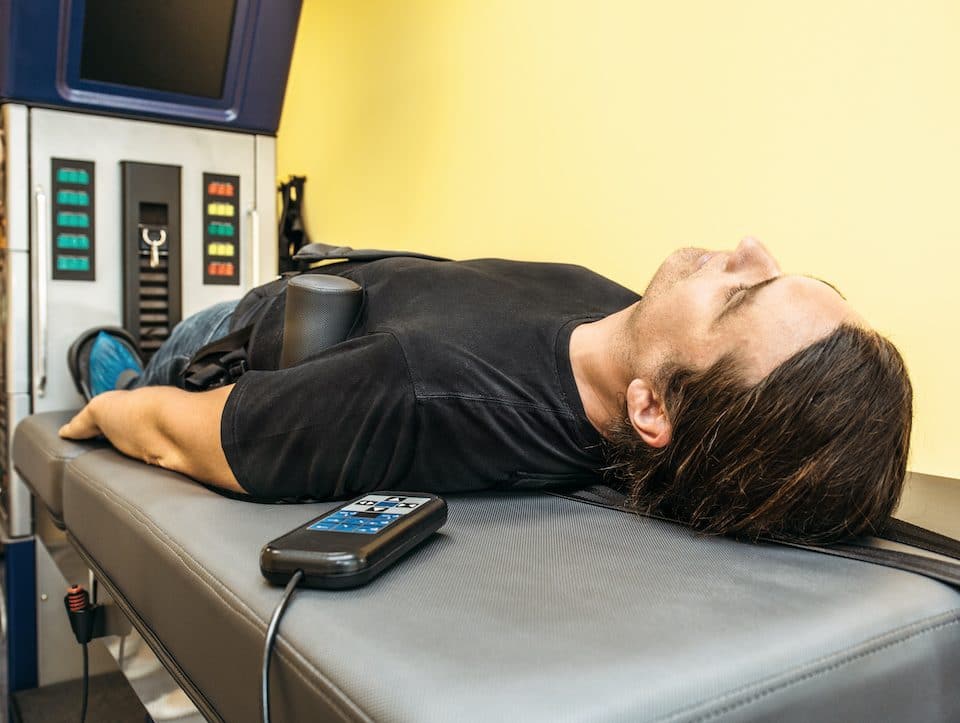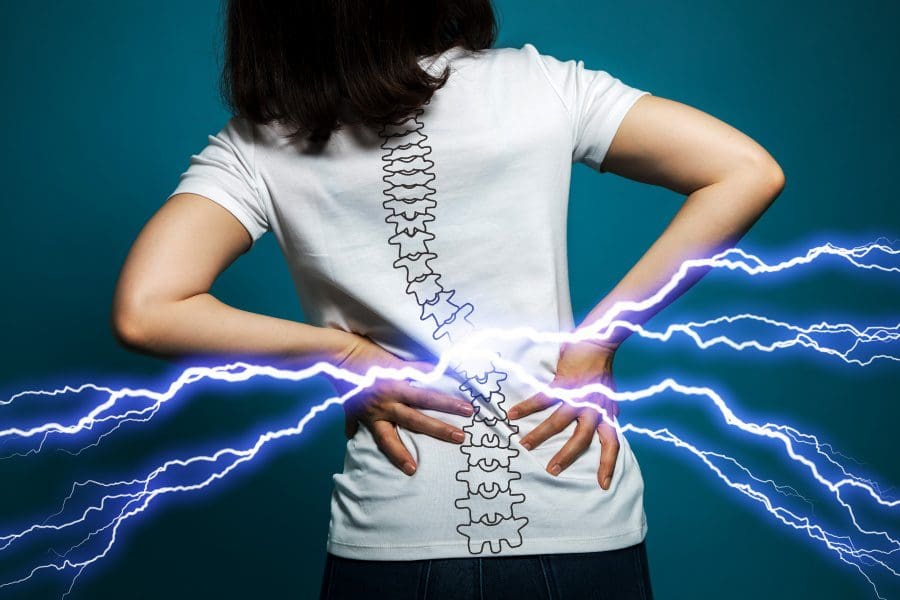Introduction
Anyone that has dealt with low back pain can describe it in various ways. Some may describe it as a mild, dull ache that can be a gradual nuisance throughout the day, while others describe it as sudden throbbing, burning pain that can radiate pain that travels down to the feet. Either way, having low back pain is horrible, and it could be developed more if people don’t change their habits to relieve back pain. Some of the risk factors can be poor lifestyle choices, common factors like looking down at your phone or lifting heavy objects, while others can be due to stress and anxiety. These risk factors can cause more pressure on the lower back; however, there are a variety of treatments that can help alleviate low back pain. Today’s article focuses on the differences between two non-surgical treatments, traction therapy and decompression therapy, and how they can relieve low back pain in their unique way. By referring patients to qualified and skilled providers specializing in spinal decompression therapy. To that end, and when appropriate, we advise our patients to refer to our associated medical providers based on their examination. We find that education is essential for asking valuable questions to our providers. Dr. Alex Jimenez DC provides this information as an educational service only. Disclaimer
Can my insurance cover it? Yes, it may. If you are uncertain, here is the link to all the insurance providers we cover. If you have any questions or concerns, please call Dr. Jimenez at 915-850-0900.
The Difference Between Traction & Decompression Therapy
Are you feeling a wide variety of pain in your lower back? Has the pain been a dull gradual ache that causes you to place your hand on your lower back? Or is it a sudden throbbing pain that hinders your ability to do any errands? This type of pain is called low back pain, and trying out either traction therapy or decompression therapy could be the answer you are looking for low back relief. Say you want to try traction therapy. Well, research studies have mentioned that traction therapy can be both manually and mechanically used to gently pulls on the spine to increase the spinal disc height while reducing the internal pressure. This allows the pain-sensitive fibers surrounding the outer layer of the spinal disc to relax. Traction therapy also allows the physical function of the spine to recover and return to normal posture; plus decreases the pain and improves the biomechanic function of the spine’s mobility. Other research studies have found that when individuals try traction therapy, the positive results show that traction therapy can help alleviate leg pain conditions like sciatica and relieve nerve root tension.
If traction therapy is not suitable for you, decompression therapy can help. As research has stated, Decompression therapy is a treatment that helps reduce the pressure off the irritated spinal nerve roots that are sending out pain signals throughout the entire lower half of the body. Decompression helps compressed, bulging discs that are touching pinched nerve roots retract back to the spine and cause the relief to the individual. That allows the reduction of muscular back spasms and loosens tense soft tissues. Additional information has been provided that decompression works well with physical therapy by restoring lumbar functionality on the spine and enhancing muscle endurance on the back. Decompression even provides relief for individuals suffering from other back pain conditions such as herniation, slipped disc, poor posture, and pinched nerves.
An Overview Of Lumbar Traction-Video
Feeling aches and pains all over your back? How about stiff muscles on your lower back when you stretch side to side? Does the pain come in a gradual or sudden throbbing way? These can be issues of low back pain and decompression, along with traction therapy can help you. The above explains what traction does while using the Chatanooga Trition machine. The machine helps many people suffering from low back pain issues and helps alleviate other chronic problems like sciatica, bulging disc, lumbar scoliosis, and pinched nerves in the lumbar region. People will feel instant relief after going in for a treatment to relieve low back pain. Suppose you want to learn more about decompression or traction therapy and how it can benefit you in relieving low back pain and other low back conditions? This link will explain what these two therapies do for the lower back.
How Both Traction & Decompression Therapy Alleviate Low Back Pain
Both traction and decompression therapy have unique ways of alleviating low back pain as both are non-surgical treatments. Research studies have demonstrated that the effects of both these treatments have increased back muscle activities through muscle endurance from the torso. Traction and decompression therapy can also provide valuable information in relieving low back pain due to degenerative changes in the spinal discs, as studies have concluded. Both treatments are excellent for many people suffering from lumbar, cervical, and leg pain, restricting their quality of life. Non-surgical treatments help people worldwide recuperate from suffering so long with back pain and help them utilize non-surgical therapy as part of their path to recovery.
Conclusion
Overall, even though traction and decompression therapy has unique functions to help alleviate pain, they both have one thing in common: they are used in non-surgical treatments to ease low back pain for many individuals. Integrating non-surgical treatments for a person’s health and wellness journey can help them live longer, develop new habits, and even help supply relief to their back. While traction therapy increases spinal disc height and decompression relieves pressure off irritated, pinched nerves, having low back pain is no laughing matter when it stops a person’s quality of life. Knowing that there are treatments for low back pain can help many individuals in the long run with their health and wellness.
References
Alrwaily, Muhammad, et al. “Assessment of Variability in Traction Interventions for Patients with Low Back Pain: A Systematic Review.” Chiropractic & Manual Therapies, BioMed Central, 17 Sept. 2018, https://www.ncbi.nlm.nih.gov/pmc/articles/PMC6139896/.
Amjad, Fareeha, et al. “Effects of Non-Surgical Decompression Therapy in Addition to Routine Physical Therapy on Pain, Range of Motion, Endurance, Functional Disability and Quality of Life versus Routine Physical Therapy Alone in Patients with Lumbar Radiculopathy; a Randomized Controlled Trial.” BMC Musculoskeletal Disorders, BioMed Central, 16 Mar. 2022, https://www.ncbi.nlm.nih.gov/pmc/articles/PMC8924735/.
Apfel, Christian C, et al. “Restoration of Disk Height through Non-Surgical Spinal Decompression Is Associated with Decreased Discogenic Low Back Pain: A Retrospective Cohort Study.” BMC Musculoskeletal Disorders, BioMed Central, 8 July 2010, https://www.ncbi.nlm.nih.gov/pmc/articles/PMC2912793/.
Horseman, Ian, and Mark W Morningstar. “Radiographic Disk Height Increase after a Trial of Multimodal Spine Rehabilitation and Vibration Traction: A Retrospective Case Series.” Journal of Chiropractic Medicine, Elsevier, Dec. 2008, https://www.ncbi.nlm.nih.gov/pmc/articles/PMC2697595/.
Kang, Jeong-Il, et al. “Effect of Spinal Decompression on the Lumbar Muscle Activity and Disk Height in Patients with Herniated Intervertebral Disk.” Journal of Physical Therapy Science, The Society of Physical Therapy Science, Nov. 2016, https://www.ncbi.nlm.nih.gov/pmc/articles/PMC5140813/.
Oh, Hyunju, et al. “The Impact of Manual Spinal Traction Therapy on the Pain and Oswestry Disability Index of Patients with Chronic Back Pain.” Journal of Physical Therapy Science, The Society of Physical Therapy Science, Dec. 2018, https://www.ncbi.nlm.nih.gov/pmc/articles/PMC6279706/.
Disclaimer
Post Disclaimer *
Professional Scope of Practice *
The information herein on "The Difference Between Traction & Decompression Therapy" is not intended to replace a one-on-one relationship with a qualified health care professional or licensed physician and is not medical advice. We encourage you to make healthcare decisions based on your research and partnership with a qualified healthcare professional.
Blog Information & Scope Discussions
Welcome to El Paso's Premier Wellness and Injury Care Clinic & wellness blog, where Dr. Alex Jimenez, DC, FNP-C, a board-certified Family Practice Nurse Practitioner (FNP-C) and Chiropractor (DC), presents insights on how our team is dedicated to holistic healing and personalized care. Our practice aligns with evidence-based treatment protocols inspired by integrative medicine principles, similar to those found on dralexjimenez.com, focusing on restoring health naturally for patients of all ages.
Our areas of chiropractic practice include Wellness & Nutrition, Chronic Pain, Personal Injury, Auto Accident Care, Work Injuries, Back Injury, Low Back Pain, Neck Pain, Migraine Headaches, Sports Injuries, Severe Sciatica, Scoliosis, Complex Herniated Discs, Fibromyalgia, Chronic Pain, Complex Injuries, Stress Management, Functional Medicine Treatments, and in-scope care protocols.
Our information scope is limited to chiropractic, musculoskeletal, physical medicine, wellness, contributing etiological viscerosomatic disturbances within clinical presentations, associated somato-visceral reflex clinical dynamics, subluxation complexes, sensitive health issues, and functional medicine articles, topics, and discussions.
We provide and present clinical collaboration with specialists from various disciplines. Each specialist is governed by their professional scope of practice and their jurisdiction of licensure. We use functional health & wellness protocols to treat and support care for the injuries or disorders of the musculoskeletal system.
Our videos, posts, topics, subjects, and insights cover clinical matters and issues that relate to and directly or indirectly support our clinical scope of practice.*
Our office has made a reasonable effort to provide supportive citations and has identified relevant research studies that support our posts. We provide copies of supporting research studies available to regulatory boards and the public upon request.
We understand that we cover matters that require an additional explanation of how they may assist in a particular care plan or treatment protocol; therefore, to discuss the subject matter above further, please feel free to ask Dr. Alex Jimenez, DC, APRN, FNP-BC, or contact us at 915-850-0900.
We are here to help you and your family.
Blessings
Dr. Alex Jimenez DC, MSACP, APRN, FNP-BC*, CCST, IFMCP, CFMP, ATN
email: coach@elpasofunctionalmedicine.com
Licensed as a Doctor of Chiropractic (DC) in Texas & New Mexico*
Texas DC License # TX5807
New Mexico DC License # NM-DC2182
Licensed as a Registered Nurse (RN*) in Texas & Multistate
Texas RN License # 1191402
ANCC FNP-BC: Board Certified Nurse Practitioner*
Compact Status: Multi-State License: Authorized to Practice in 40 States*
Graduate with Honors: ICHS: MSN-FNP (Family Nurse Practitioner Program)
Degree Granted. Master's in Family Practice MSN Diploma (Cum Laude)
Dr. Alex Jimenez, DC, APRN, FNP-BC*, CFMP, IFMCP, ATN, CCST
My Digital Business Card





